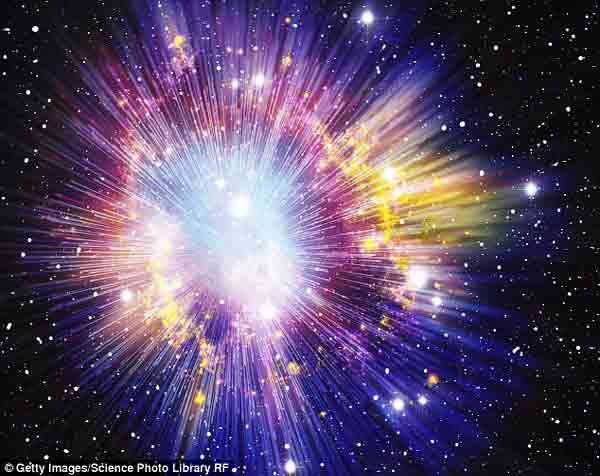

Instead of springing into existence, the expanding universe may have been preceded by a contraction phase. The idea stems from the theory that a ‘Big Crunch’, in which the universe collapses on itself, could lead to an ‘eternal succession of universes.’ Artist's impression
Sao Paulo, Brazil (BBN) - What if the Big Bang never happened?
The theory is the most widely accepted explanation for the birth and evolution of our universe, and has come to be crucial in our understanding of the cosmos.
But, some physicists are now challenging the idea of ‘the beginning of time,’ reports Daily Mail.
Instead of a Big Bang event that started it all 13.7 billion years ago, some suspect the universe may experience ‘bouncing’ phases of contraction and expansion.
THE 'BIG BOUNCE'
Researchers say the start of the universe may have sprung as it transitioned from a previously contracting state.
They suggest that all particles in the early universe would have been governed by the laws of quantum mechanics.
So rather than collapsing and destroying itself at the end of a period of contraction, the universe was likely saved by quantum mechanics.
This would mean the universe did not experience a violent beginning or ending, as in the Big Bang and Big Crunch scenarios.
‘I believe the Big Bang never happened,’ said physicist Julian Cesar Silva Neves, who works as a researcher at the University of Campinas’ Mathematics, Statistics & Scientific Computation Institute (IMECC-UNICAMP) in Sao Paulo State, Brazil.
In a new study published to the journal General Relativity and Gravitation, Neves argues that there may be no need for the spacetime singularity – or, the Big Bang.
Instead of springing into existence, the current expanding universe may have been preceded by a contraction phase.
The idea stems from the theory that a ‘Big Crunch’, in which the universe collapses on itself, could lead to an ‘eternal succession of universes.’
The process would create extremes in temperature and density, leading to an inversion and a ‘bounce’ that allows for expansion.
‘In order to measure the rate at which the Universe is expanding with the standard cosmology, the model in which there’s a Big Bang, a mathematical function is used that depends only on cosmological time,’ said Neves.
‘Eliminating the singularity or Big Bang brings back the bouncing Universe on to the theoretical stage of cosmology.
‘The absence of a singularity at the start of spacetime opens up the possibility that vestiges of a previous contraction phase may have withstood the phase change and may still be with us in the ongoing expansion of the Universe.’
The new argument is inspired by the behaviour of ‘regular’ black holes.
In a black hole, the core contracts to form a singularity, with extreme density and gravitational attraction.
But, Neves argues that this singularity does not define a black hole – instead, the event horizon does, or the ‘membrane’ which indicates the point of no return.
‘Outside the event horizon of a regular black hole, there are no major changes, but inside it, the changes are deep-seated,’ Neves says.
‘There’s a different spacetime that avoids the formation of a singularity.’
Neves and supervisor lberto Vazques Saa, a Professor at IMECC-UNICAMP, devised a scale factor inspired by physicist James Bardeen, who considered the mass of a black hole not as a constant, but as something dependent on the distance to the center.
This modified the solution to the general relativity equations on black holes, and gave rise to what’s known as the ‘regular’ black hole.
‘Regular black holes are permitted, since they don’t violate general relativity,’ said Neves.
‘The concept isn’t new and has frequently been revisited in recent decades.’
The researchers used a similar approach to eliminate the singularity.
Neves says the hypothesis can be tested ‘by looking for traces of the events in a contraction phase that may have remained in the ongoing expansion phase.’
This could include ‘remnants of black holes from a previous phase of universal contraction that may have survived the bounce.’
BBN/MMI/ANS